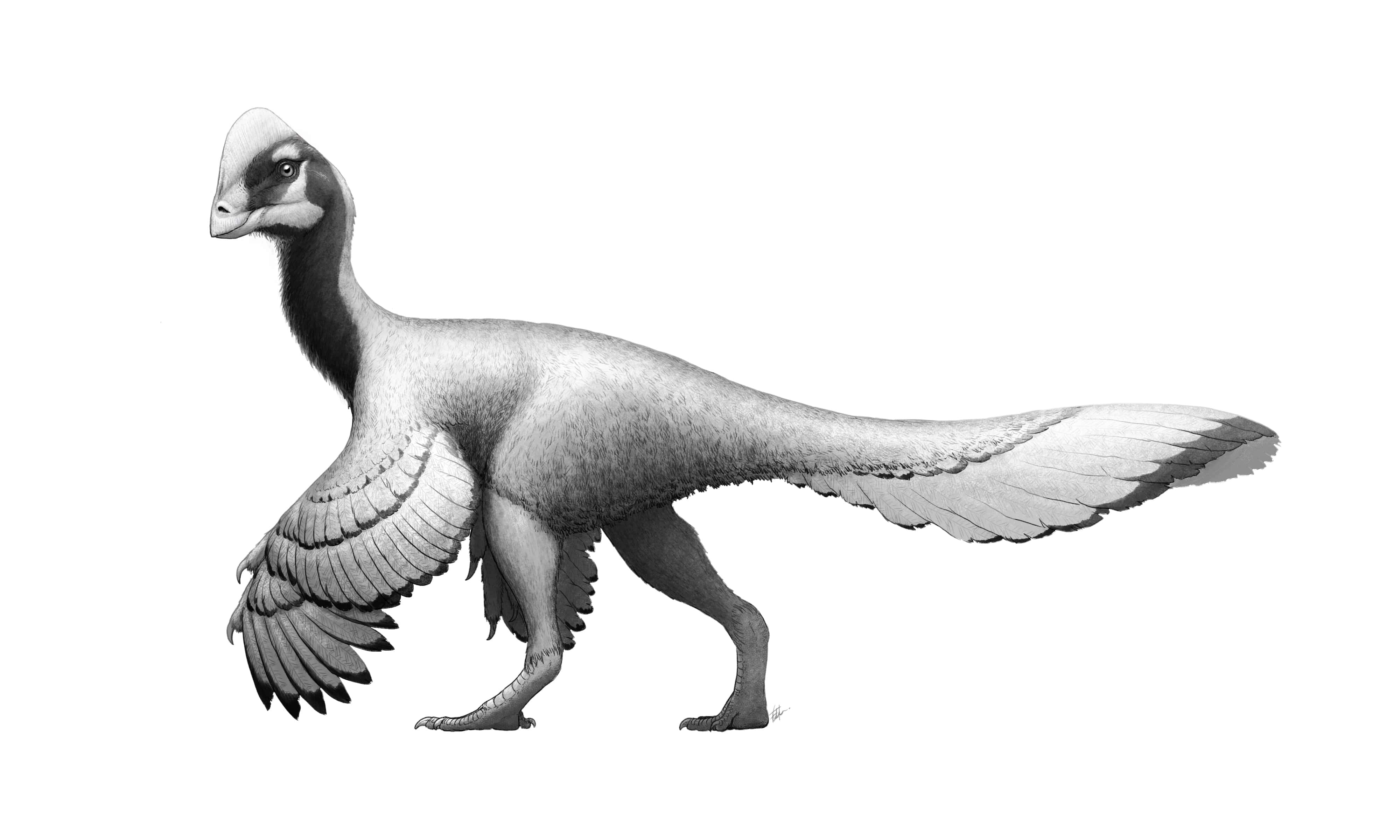
Anzu wyliei is a strange bird-like creature.
It has an unusually high and thin bony crest on its skull.
This dino has a huge beak with sharp edges without teeth. The anatomy of the jaw joint is equally extraordinary. The lower jaw can be shifted forward and backward in a sliding motion, probably to "cut" food.
In addition, Anzu had feathers on his upper arms.
Because of its appearance and the place where it was found called "Hell Creek Formation", it was nicknamed "Chicken from Hell".
| Profile | Anzu wyliei |
|---|---|
| Prehistoric Era | late Cretaceous, about 67.2 - 66 million years ago |
| Order | Saurischia |
| Suborder | Theropoda |
| Family | Caenagnathidae |
| Tribe | Caenagnathinae |
| Genus | Anzu |
| Species | Anzu wyliei |
| Height | 1.5 meter |
| Length | 3 to 3.5 meter |
| Weight | 200 kg to 300 kg |
| Territory | North Dakota and South Dakota |
He was up to 3.5 meters long and his waist height was 1.50 meters. His weight is estimated at 200 to 300 kg.
He resembled a large flightless bird with feathers on his tail and arms. The neck and hind legs were long and slender and look not unlike an ostrich. However, the front limbs were equipped with large sharp claws.
In addition, Anzu had a long tail like a lizard, which again negates the resemblance to an ostrich.
Scientists assume that Anzu was able to run very fast.
He was not specialized in any particular ecological niche. The anatomy of his jaw indicates that he could eat a variety of different foods. It is thought that it ate both plants and small animals, and may even have been able to open and eat eggs.
Anzu is not related to birds, but his bird-like features suggest that he exhibited many bird-like behaviors. The large crest on its head, made of extremely thin bone, was probably used only for display. Similarly, the Cassowary, which lives in Australia, uses its comb to attract mates.
It belongs to a group of dinosaurs known as Oviraptorosauria. Most evidence of its existence comes from fossils discovered in Central and East Asia.
About the size of a small car, the dinosaur also had claws and feathers on its upper arms.
Scientists realized early on that the bones they found belonged to a carnivorous dinosaur.
This is because the bones of carnivorous dinosaurs are hollow, and the bones found were hollow.
The dinosaur was assembled and identified using parts from three skeletons collected in North and South Dakota.
Together they result in an almost complete skeleton, which allows good conclusions about its appearance.
Approximately 80% of the skeleton could be reconstructed this way.
Two partial skeletons were found by private collectors and later acquired by the Carnegie Museum of Natural History in Pittsburgh;
Mike Triebold
Nuss family
The third partial skeleton was uncovered by Tyler Lyson and his team from the Smithsonian's National Museum of Natural History, in North Dakota.
Lyson was also one of four scientists who worked together to determine the genus Anzu.
The quartet also included Hans-Dieter Sues, curator of vertebrate paleontology in the Department of Paleobiology at the National Museum of Natural History; lead author Matthew Lamanna, assistant curator of vertebrate paleontology at the Carnegie Museum of Natural History; and Emma Schachner, postdoctoral researcher at the University of Utah in Salt Lake City.
Matthew Lamanna, who came up with the species' name, originally wanted to use a Latin or Greek version of "chicken from hell."
However, that term did not translate well, so he chose the name Anzu. A bird-like demon from Sumerian mythology. This term can be roughly translated as "celestial eagle."
All three Anzu skeletons are now housed in the Carnegie Museum of Natural History in Pittsburgh.
image source: Fred Wierum, CC BY-SA 4.0 https://creativecommons.org/licenses/by-sa/4.0, via Wikimedia Commons
Skull: Kabacchi, CC BY 2.0 https://creativecommons.org/licenses/by/2.0, via Wikimedia Commons
Skeleton: Tadek Kurpaski from Pittsburgh,PA, USA, CC BY 2.0 https://creativecommons.org/licenses/by/2.0, via Wikimedia Commons
Hand: James St. John, CC BY 2.0 https://creativecommons.org/licenses/by/2.0, via Wikimedia Commons